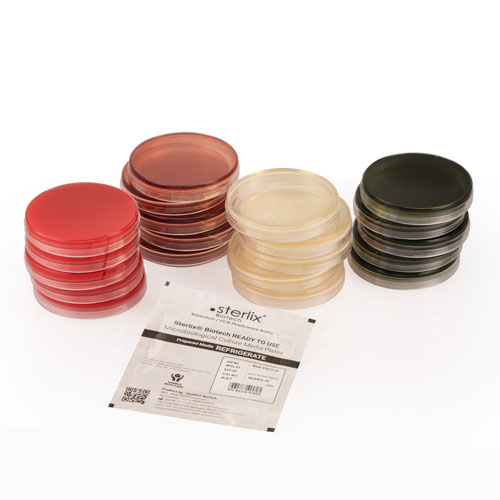STERLIX® TSI Agar Ready To Use Medium (Triple Sugar, Iron Agar) Slant
Product Details
TSI Agar Medium (Triple Sugar Iron Agar) is a differential and selective culture medium used for the identification of enteric bacteria, particularly members of the Enterobacteriaceae family. TSI Agar contains three sugars (glucose, lactose, and sucrose) as well as iron salts, which allow for the differentiation of bacteria based on their ability to ferment these sugars and produce hydrogen sulfide gas.
The composition of TSI Agar Medium typically includes:
Peptone: Peptone serves as a source of nitrogen and other essential nutrients for bacterial growth.
Beef Extract: Beef extract provides additional nutrients for bacterial growth.
Lactose, Glucose, and Sucrose: These three sugars are included in the medium to determine the fermentative capabilities of the bacteria being tested. Bacteria that can ferment the sugars will produce acid, which causes a color change in the medium.
Phenol Red: Phenol red is a pH indicator that changes color based on the acidity or alkalinity of the medium. It turns yellow in an acidic environment (fermentation of sugars) and red in an alkaline environment (no sugar fermentation).
Sodium Thiosulfate and Ferrous Ammonium Sulfate: These compounds are added to the medium to detect the production of hydrogen sulfide gas. Bacteria that can produce hydrogen sulfide will react with these compounds, resulting in the formation of a black precipitate.
Agar: Agar is added as a solidifying agent, providing a solid surface for bacterial growth and colony formation.
TSI Agar Medium is primarily used to differentiate bacteria based on their ability to ferment sugars and produce hydrogen sulfide gas. The observed results on TSI Agar can provide important information about the bacterial species being tested. The possible interpretations of TSI Agar results include:
Acid production only in glucose: This indicates that the bacteria can ferment glucose but not lactose or sucrose
Acid production in glucose, lactose, and/or sucrose: This indicates that the bacteria can ferment one or more of the sugars.
Acid production with a yellow slant and black precipitate: This indicates that the bacteria can ferment one or more sugars and produce hydrogen sulfide gas.
Alkaline reaction (red color): This indicates that the bacteria cannot ferment any of the sugars.
TSI Agar Medium is a valuable tool for the preliminary identification and differentiation of enteric bacteria based on their sugar fermentation patterns and hydrogen sulfide production. It is commonly used in clinical microbiology laboratories and other settings for the detection and characterization of enteric pathogens.
It is important to follow proper laboratory techniques and guidelines when using TSI Agar Medium to ensure accurate and reliable results. Interpretation of TSI Agar results should be done in conjunction with additional tests and confirmatory procedures for accurate bacterial identification.
The composition of TSI Agar Medium typically includes:
Peptone: Peptone serves as a source of nitrogen and other essential nutrients for bacterial growth.
Beef Extract: Beef extract provides additional nutrients for bacterial growth.
Lactose, Glucose, and Sucrose: These three sugars are included in the medium to determine the fermentative capabilities of the bacteria being tested. Bacteria that can ferment the sugars will produce acid, which causes a color change in the medium.
Phenol Red: Phenol red is a pH indicator that changes color based on the acidity or alkalinity of the medium. It turns yellow in an acidic environment (fermentation of sugars) and red in an alkaline environment (no sugar fermentation).
Sodium Thiosulfate and Ferrous Ammonium Sulfate: These compounds are added to the medium to detect the production of hydrogen sulfide gas. Bacteria that can produce hydrogen sulfide will react with these compounds, resulting in the formation of a black precipitate.
Agar: Agar is added as a solidifying agent, providing a solid surface for bacterial growth and colony formation.
TSI Agar Medium is primarily used to differentiate bacteria based on their ability to ferment sugars and produce hydrogen sulfide gas. The observed results on TSI Agar can provide important information about the bacterial species being tested. The possible interpretations of TSI Agar results include:
Acid production only in glucose: This indicates that the bacteria can ferment glucose but not lactose or sucrose
Acid production in glucose, lactose, and/or sucrose: This indicates that the bacteria can ferment one or more of the sugars.
Acid production with a yellow slant and black precipitate: This indicates that the bacteria can ferment one or more sugars and produce hydrogen sulfide gas.
Alkaline reaction (red color): This indicates that the bacteria cannot ferment any of the sugars.
TSI Agar Medium is a valuable tool for the preliminary identification and differentiation of enteric bacteria based on their sugar fermentation patterns and hydrogen sulfide production. It is commonly used in clinical microbiology laboratories and other settings for the detection and characterization of enteric pathogens.
It is important to follow proper laboratory techniques and guidelines when using TSI Agar Medium to ensure accurate and reliable results. Interpretation of TSI Agar results should be done in conjunction with additional tests and confirmatory procedures for accurate bacterial identification.

